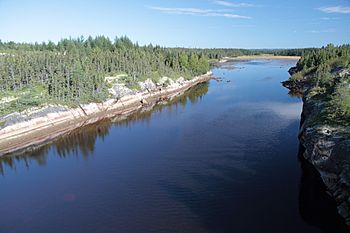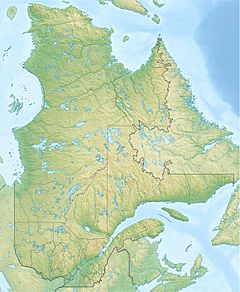Pashashibou River facts for kids
Quick facts for kids Pashashibou River |
|
|---|---|

The river near its mouth, looking north from Quebec Route 138
|
|
| Native name | Pihu Hipu |
| Other name(s) | Rivière Pashashibou |
| Country | Canada |
| Province | Quebec |
| Region | Côte-Nord |
| RCM | Minganie |
| Physical characteristics | |
| Main source | Lake Costebelle |
| River mouth | Gulf of Saint Lawrence 0 metres (0 ft) 50°16′39″N 62°20′55″W / 50.2775°N 62.3486111°W |
| Length | 17 kilometres (11 mi) |
| Basin features | |
| Basin size | 154 square kilometres (59 sq mi) |
The Pashashibou River (which is Rivière Pashashibou in French) is a beautiful river located in the Côte-Nord region of Quebec, Canada. It flows into the large Gulf of Saint Lawrence, which is part of the Atlantic Ocean. This river is an important natural feature in its area.
Contents
Where is the Pashashibou River?
The Pashashibou River starts its journey in a place called Lake Costebelle. From there, it flows south for about 17 kilometres (11 mi) (about 10.5 miles). It eventually reaches Pashashibou Bay, which is part of the Gulf of Saint Lawrence.
River's Path and Size
For the first 10 kilometres (6.2 mi) (about 6 miles) from where it meets the sea, the river is wide enough for a canoe. After that, it becomes much smaller, more like a stream. The river's mouth is located about 40 kilometres (25 mi) (about 25 miles) west of a town called Natashquan. The exact spot where the river meets the sea is in the municipality of Aguanish. This area is part of the Minganie Regional County Municipality.
Protecting Wildlife at the River Mouth
The land along the coast, on both sides of the river's mouth, is a special protected area. It's called the Pashashibou Bay Waterfowl Concentration Area. This area covers about 10.88 square kilometres (4.20 sq mi) (about 4.2 square miles). It was created in 2005 to protect many different types of water birds that gather there. The Ministry of Forests, Wildlife and Parks helps manage this important wildlife habitat.
What Does "Pashashibou" Mean?
The name of the river has a special meaning from the local Indigenous people. The Innu people from Natashquan call this river Pihu Hipu. This name means "river with a lynx," which is a type of wild cat.
Old Names and Meanings
Long ago, in 1535, an explorer named Jacques Cartier called the bay "Havre sainct Nicollas." The current name, Pashashibou, comes from the Innu language. It is thought to come from the term pishi-shebau. This can mean either "sharp rock" or "dry river."
About the River's Surroundings
A book from 1914, called Dictionnaire des rivières et lacs de la province de Québec, described the Pashashibou River. It said the river is small but fairly easy to travel by canoe for about seven miles from the sea, up to the first lake.
Land and Trees Around the River
Beyond that first lake, the river becomes a small stream. It's too narrow for canoes for about ten miles, until it reaches a large lake. This big lake, about three miles wide, is where the river begins. The land near the river is mostly flat and made of clay, which is good for farming, at least up to the first lake. Further inland, the land becomes rocky and mountainous. According to a surveyor named Hould in 1894, the main trees found there are pines and firs. Some of these trees are large enough to be used for wood.
The River's Basin
The area of land that drains water into the Pashashibou River is called its basin. This basin covers about 154 square kilometres (59 sq mi) (about 59 square miles).
Where the Basin is Located
Part of the river's basin is in an area called Lac-Jérôme, which doesn't have a local government. The other part is in the municipality of Aguanish. The Pashashibou River basin is located between two other river basins: the Little Watshishou River basin to its west and the Nabisipi River basin to its east. Maps of Quebec's natural regions show that the river basin is in areas known for spruce trees and moss.


